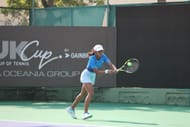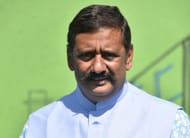Guided by Mr. Sunder Iyer, Hon. Secretary of MSLTA, India has hosted three international-level tournaments during the past year or so, with the Challengers Tour (Men), WTA (Women), and the Billie Jean King Cup (Women) among them.
These international-level tournaments have seen some of the world's top-ranked players compete in India, with Pune and Mumbai becoming the tennis hubs to organize international tournaments for the nation. MSLTA has done all this while providing the appropriate exposure to young players, the most notable of whom is 15-year-old Maaya Rajeshwaran, a wildcard participant in the WTA Mumbai Open who reached the semi-finals.

They are offering the best infrastructure to the upcoming players in India and motivating the next generation of Indian tennis players by giving them the appropriate support at the grassroots level.
In a comprehensive interview, Mr. Sunder Iyer, Honorary Secretary of the Maharashtra State Lawn Tennis Association (MSLTA), shared insights on the challenges and opportunities in hosting international tennis tournaments and the vision for developing tennis in India.

When asked about the challenges faced in hosting major tournaments, Iyer explained that securing hosting rights involves intense competition.
"Yeah, obviously to get a tournament like this is not very easy. There are other 8 countries, other 6 countries over here who also have bid for the event," said Iyer.
The bidding process for the tournament had been ongoing for two years before India's bid was accepted. "Obviously they have been trying to bid for this tournament for the last 2 years. And this year our bid was accepted by the ITF board, the BKJC board. And I think it's a great honor for India, for AITA to host an event like this," Iyer stated.
He added that organizing such events comes with significant costs and logistical challenges.
"Obviously it is very expensive to have an event like this, even though there are 6 teams. Because there is so much logistics. There is food, there is hotel, there is transportation. Being in Pune, you know, we had to get people from Mumbai to ride on all the way here," he explained.
Despite these challenges, Iyer emphasized the benefits for Indian players:
"But these are some challenges, but obviously it's all worth it. Because you are giving our players an opportunity to play at home. Home conditions, tea, whatever I mean you want to say. They have their parents with them. So this liberty is never available to any of us when we go abroad."
Mumbai and Pune as tennis hosting destinations
Emphasizing that Mumbai and Pune remain top choices for international tournaments, Iyer highlighted the excellent facilities available:
"See obviously Mumbai, Pune have a good facility. The event we are hosting in Mahalunge Balewadi tstadium came during the 2008 Youth Commonwealth Games."
He also described the venue's features:
"It's a beautiful stadium, 3,400 to 2,800 people capacity. We have 6 practice courts. We have everything you need for a... Because it was built that way during that time."
The facilities were designed with future international events in mind:
"We ensured from the government that we got it built in a way that we could host bigger events. In 2008 nobody knew that we would host an ATP Tournament. We would host a Challenger, we would host a WTA event. And now we would host a Davis Cup and now the BJKC (Billie Jean King Cup)."
Regarding Mumbai's facilities, Iyer noted:
"If you look at Mumbai, the CCI club is one of the best clubs in the world. And to have a tournament like that, though we need to invest a lot of money in putting up the court. In putting up a stadium in Mumbai. Mumbai needs a world class facility for sure. Because it's a big city. And I think Mumbai also needs a stadium like Pune."
Long-term impact on tennis in Maharashtra and vision for Indian tennis
Discussing the long-term impact of hosting international events on grassroots tennis, Iyer highlighted MSLTA's history of organizing tournaments:
"See obviously, like I told you earlier, Maharashtra has always been... Right from the 2000s, we always used to do international events. But now it has grown."
MSLTA has implemented robust development programs for young players:
"Secondly, we have a very robust program for our juniors. We support our juniors, we give them scholarships, we do camps for them, we send them abroad. And we run a program called the Vision Program, which we have been doing for the last 15 years."
These programs have produced notable athletes:
"And the success is that we have had Olympians like Prarthana Thombare, we have had Asian gold medalists like Rutuja Bhosale. We have top 100 players in the doubles like Arjun Kadhe, now Siddhant Banthia. So these are all products of our program. And obviously now we have Vaidehi (Chaudhari) and Vaishnavi Adkar, who are knocking the doors of the continent."
Asked about his broader vision for Indian tennis over the next five years, Iyer expressed optimism about the emerging talent:
"Obviously Indian tennis needs to go up. I mean obviously the new generation of players are very very talented and very focused."
"We also need to concentrate on the North East states, we need to ensure that older tennis players, former tennis players are brought into the system as mentors. We need to hand them over to kids to ensure that they give experience to our kids to do well."
He also expressed confidence in future results:
"We are right now poised in such a way that if we do the right things, I am sure that we will see the results in the next 4 or 5 years. Because our players are hungry, they want to do better. If we give them a good playing field, I am sure the results will come."
"The competition is tremendous": MSLTA Secretary on facing European dominance in global tennis
When asked about his message to young players, Mr. Iyer acknowledged the global challenges:
"Obviously tennis is a tough game which is played in more than 200 countries which makes it a real global sport. Competition is tremendous, we are fighting against players from Europe who have better facilities, who have better reach to play tournaments. For Indians it is very difficult, for Asians to go to Europe is very difficult."
Despite these challenges, he emphasized the need to build local infrastructure in his concluding statements:
"But still we need to build up our own professional structure, have many more international events. I am really happy to mention that Sports Authority of India is coming in a very big way to help the federations. And obviously we also are doing so many tournaments in India and thanks to Sports Authority of India for coming out for it."
